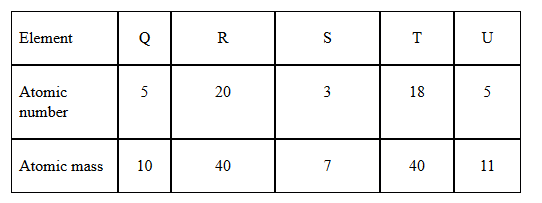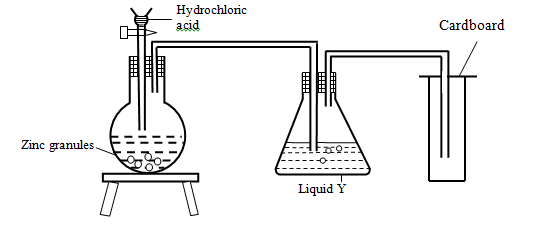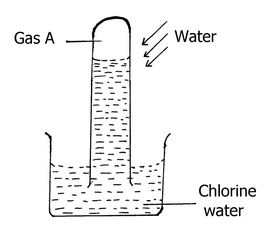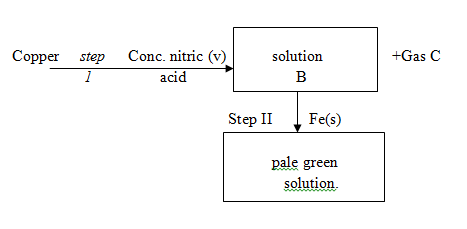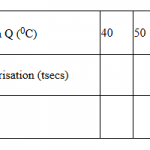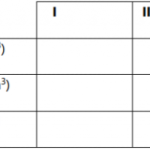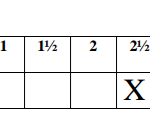KCSE Chemistry Paper 1 – Kabarak High School Mock 2015
Mock 2015 – Kabarak High School
Chemistry Paper 1
(a) What is the importance of the shape of a conical flask? (1 mark)
1 marks
A mixture consists of sulphur powder and iron filings.
(i) Describe how to obtain sulphur from the mixture using methylbenzene. (2 marks)
(ii) Is the mixture homogeneous or heterogeneous? Explain. (1 mark)
3 marks
Nitrogen gas can be prepared in the laboratory using a mixture of ammonium chloride solution and sodium nitrite solution.
(a) The reaction occurs in two steps. State the two steps in the correct order. (2 marks)
(b) State two uses of nitrogen. (1 mark)
3 marks
(a) Draw structural formulae of two positional isomers with molecular formula C4H8. (2 marks)
(b) Study the equation below and answer the questions that follow.
(i) State the condition under which this reaction occurs. (1 mark)
(ii) Give the general name of this type of reaction. (1 mark)
4 marks
(a) Define hydration energy. (1 mark)
(b) Given that: the hydration energies of Ca2+ and Cl– are -1891 kJ mol-1 and -384 kJ mol-1 respectively, and that the lattice energy of calcium chloride is +2237 kJ mol-1.Calculate the molar enthalpy change of solution of calcium chloride. (3 marks)
4 marks
The standard electrode potentials of a metal G and iron are given below.
A piece of iron is coated with metal G. If the coating is scratched, would the iron be protected form rusting? Explain. (3 marks)
3 marks
(a)Why is the percentage of carbon (IV) oxide in the atmosphere fairly constant? (1 mark)
(b) Calculate the volume of carbon(IV)oxide in 8,000 m3 of air contained in a hall.(2 marks)
3 marks
State two conditions that would make the boiling point of water to be higher than 100oC. (2 marks)
2 marks
Explain the effects of the accumulation of nitrogenous compounds in water masses? (2 marks)
2 marks
Study the table below and use it to answer the questions that follow. (The letters do not represent the actual symbols of the elements).
(a) Select two letters that represent the same element? Give a reason. (2 marks)
(b) Give the number of neutrons in an atom of element S. (1 mark)
3 marks
Dry carbon (II) oxide gas was passed over heated lead (II) oxide.
(a) Write an equation for the reaction. (1 mark)
(b) Give one industrial application of the above reaction. (1 mark)
(c) Name another gas that can be used in the above reaction. (1 mark)
3 marks
(a) Proteins are obtained from amino acids monomers. Complete the equation below to show the polymer formed. (1 mark)
(b) Name the type of polymerization shown above. (1 mark)
2 marks
The set up below was used to prepare dry hydrogen gas. Study it and answer the questions that follow.
(i) With a reason, identify the mistake in the set-up above. (1 mark)
(ii) What would be liquid Y? (1 mark)
3 marks
Study the following equilibrium equation.
(a) Suggest two ways of increasing the yield of X2Y. (1 mark)
(b) Draw the energy level diagram for the forward reaction. (2 marks)
3 marks
5.0g of calcium carbonate were allowed to react with 25cm3 of 1.0M hydrochloric acid until there was no further reaction. Calculate the mass of calcium carbonate that remained unreacted. (3 marks)
(Ca = 40, C = 12, O = 16)
3 marks
(a) State Graham’s law of diffusion. (1 mark)
(b) 50cm3 of Carbon (IV) Oxide diffuses through a porous plate in 15 seconds. Calculate the time taken by 75cm3 of Nitrogen (IV) Oxide to diffuse through the same plate under similar conditions. (C = 12, 0 = 16, N = 14) (2 marks)
3 marks
A student fetched water from a river in a limestone area. He used it for washing and realized that it did not lather easily.
(i) Name the two ions that prevent lathering. (1 mark)
(ii) Given that the structure of soap is C17H35COONa.
Explain by means of ionic equations how the above ions prevent lathering. (2 marks)
3 marks
A student burnt magnesium ribbon in a gas jar full of sulphur (IV) oxide gas.
(i) State two observations made in the gas jar. (2 marks)
(ii) Write an equation for the reaction that took place. (1 mark)
3 marks
M grammes of a radioactive isotope decayed to 5 grammes in100 days. The half life of the isotope is 25 days.
- What is meant by half life? (1 Mark)
- Calculate the initial mass M of the radioactive isotope. (2 Marks)
3 marks
(i) With the aid of a well labeled diagram, show that the innermost region of a non luminous flame consist of unburnt gas. (1½ marks)
(ii) Highlight the steps followed when lighting a Bunsen burner. (1½ marks)
3 marks
The diagram below shows an experiment involving chlorine water.
a)State and explain the observations made after 24 hours. (2 marks)
b)Write an equation to show the formation of gas A. (1mark)
c)State one use of chlorine gas. (1mark)
4 marks
Study the reaction scheme below and the answer questions that follow
i) Identify: (2mark)
(a) Solution B
(b) Gas C
ii)What type of reaction is taking place in step II (1mark)
3 marks
a) Define solubility. (1 mark)
b) In an experiment to determine the solubility in water at 300c, the following results were obtained.
Mass of empty evaporating dish = 26.2g
Mass of evaporating dish + saturated solution = 42.4g.
Mass of evaporating dish + dry solid Y = 30.4g
Use this data to calculate the solubility of Y at 300C . (3 marks)
4 marks
In terms of structure and bonding. Explain why water (H2O) is a liquid at room temperature while Hydrogen sulphide (H2S) is a gas. (2 marks)
2 marks
Explain why hard water flowing in lead pipes may be safer for drinking than soft water flowing in the same pipes. (2 marks)
2 marks
Air was passed through reagents as shown below.
i)State and explain the observations made when air is passed through chamber A for a long time. (2 marks)
ii) Name one component in Explain (1 mark)
3 marks
Using dots (·) and crosses (x), draw the dimer structure of aluminium chloride and name the bonds. (Al=13, Cl=17) (2 marks)
2 marks
Iron is extracted from its ore by the blast furnace process.
a) Name the chief ore from which iron is extracted from. (1 mark)
b) An ore is suspected to contain mainly iron. Describe a method that can be used to confirm the presence of iron in the ore. (2 marks)
3 marks


